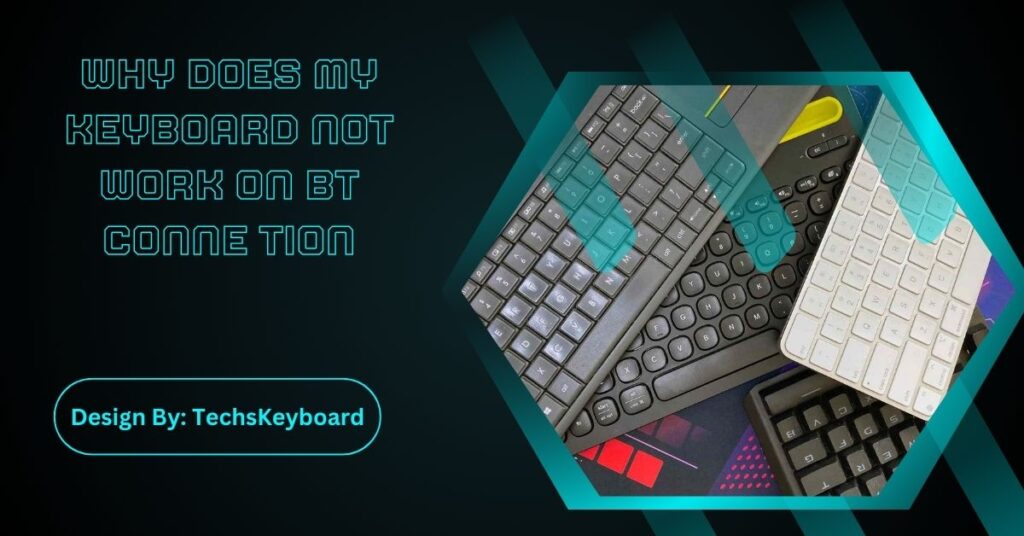Bluetooth keyboard issues often stem from battery problems, pairing errors, interference, outdated drivers, or software glitches. Troubleshooting these problems can resolve most connectivity issues and restore functionality.
It can be super annoying when your Bluetooth keyboard doesn’t work as it should. You’re pressing keys, but nothing happens—and maybe you’re not sure why. Don’t worry, though; you’re not the only one facing this problem. Many people experience Bluetooth keyboard issues, but the good news is that most of these problems are easy to solve.
This guide will walk you through the common reasons why your keyboard might not work with a Bluetooth (BT) connection and give you step-by-step fixes that anyone can follow. By the end, you’ll know exactly what to do to get your keyboard working smoothly again.
Common Reasons for Bluetooth Keyboard Issues (and Easy Fixes):
1. Battery Problems
Batteries are a small thing, but they can cause big issues! If your keyboard doesn’t have enough power, it won’t turn on or connect properly. Sometimes, even if you’ve just replaced the batteries, there could still be a problem.
Signs of Battery Problems:
- The keyboard doesn’t respond or light up.
- Connection keeps dropping out.
- Lights on the keyboard (if any) are faint or not working.
What to Do:
- Replace the Batteries: If your keyboard uses standard disposable batteries, try putting in fresh ones. For rechargeable keyboards, plug them in and fully recharge.
- Check for Damage: Look at the battery area for any signs of corrosion or leaks. If you see white or rust-like spots, clean them gently with a cotton swab and a bit of vinegar to restore the connection.
- Keep Spare Batteries: Always have extra batteries within reach. This saves you stress when your keyboard suddenly dies.
Example:
Imagine writing an important email or playing a game, and everything stops because the keyboard battery dies. Avoid this by checking your battery level often. Some keyboards even have an app or light indicator to warn you when the power is running low.
2. Pairing Problems
Your Bluetooth keyboard won’t work unless it’s properly paired with your device. Pairing is like introducing your keyboard to your computer, tablet, or phone. If there’s an error here, the two devices won’t communicate.
What Might Cause Pairing Problems:
- Your keyboard is still connected to another device.
- The pairing process wasn’t done correctly.
- Bluetooth is accidentally turned off on your device.
How to Fix Pairing Problems:
- Unpair Old Connections: If your keyboard is still connected to another device, like your phone, it won’t pair with your computer. Go to the Bluetooth settings on any connected devices and disconnect the keyboard.
- Restart Pairing Mode: Put your keyboard in pairing mode. Usually, this means holding down a button (often labeled “Connect” or “Bluetooth”) until a light blinks.
- Try Again: On your device, find your keyboard in the list of available Bluetooth devices and tap to connect.
Pro Tip:
Keep your device and keyboard close together—Bluetooth works best when they’re less than 10 feet apart. Also, after pairing, test the keyboard to make sure the connection is stable.
Example:
You’re trying to connect your keyboard to your tablet, but it doesn’t show up. This could happen because your keyboard is still linked to your laptop. Disconnect from the laptop first, and then try pairing again.
Also Read: How To Mount Portable Music Keyboard On Wall – Complete Guide!
3. Interference From Other Devices
Did you know that Bluetooth devices share the same wireless frequency as many other electronics, like Wi-Fi routers, baby monitors, and even some cordless phones? If there are too many devices nearby, they might “fight” and cause interference for your keyboard.
Signs of Interference:
- Your keyboard connects but doesn’t respond to keystrokes.
- Connection drops when other devices are turned on.
How to Fix Interference:
- Move Closer: Make sure your keyboard and device are close to each other. Avoid putting objects (like walls or metal furniture) between them.
- Turn Off Other Wireless Devices: If possible, temporarily switch off unused Wi-Fi routers, Bluetooth headphones, or other gadgets to see if they’re causing the problem.
- Try Another Spot: If interference is still an issue, move to a different area to test the keyboard.
Example:
Your keyboard stops working every time your roommate starts a video call. This might mean their Wi-Fi router is causing interference. Try using the keyboard in another room to avoid the clash.
4. Outdated or Missing Drivers
Drivers are like translators for your computer—they help your hardware (like your keyboard) talk to your software. If the Bluetooth drivers on your computer are outdated or missing, your keyboard might not connect properly.
Signs of Driver Issues:
- Keyboard works on other devices but not on your computer.
- Error messages appear, saying “driver not found” or “device not recognized.”
Easy Solutions:
- For Windows Computers:
- Open the “Device Manager” (you can search for it in the Start menu).
- Look under “Bluetooth” or “Keyboards” for your device.
- Right-click and choose “Update Driver.” Follow the on-screen steps.
- For Mac Users:
- Go to “System Preferences” > “Software Update.”
- Make sure your macOS is up to date because updates often include the latest drivers.
Example:
If your Bluetooth keyboard pairs perfectly with your phone but doesn’t work with your laptop, outdated drivers might be the reason. Updating them could solve the issue in under 10 minutes.
5. Software or Firmware Bugs
Even tech can have bad days! Sometimes, bugs in your device’s software or the keyboard itself can make Bluetooth connections unreliable.
What to Do:
- Restart Devices: Turn off your keyboard and your device (phone, tablet, or computer), then turn them back on.
- Reset the Keyboard: Look in the manual to find instructions for resetting your keyboard to factory settings. This clears out old connections and starts fresh.
- Update Firmware: Visit the manufacturer’s website to check for firmware updates for your keyboard. These updates are like fixes the company releases to solve common issues.
Example:
After weeks of working fine, your keyboard suddenly stops responding. It might just need a quick reset or firmware update to get back on track.
Extra Troubleshooting Tips:
- Test on Another Device: If your keyboard doesn’t work after several tries, connect it to a different device. This can help you figure out if the problem is with the keyboard or the device you’re trying to use.
- Disable Airplane Mode: Make sure Airplane Mode isn’t on, as it disables Bluetooth along with Wi-Fi.
- Reinstall the Keyboard App: If your keyboard came with an app, reinstall it. This can fix any software-related glitches.
Also Read: How To Have My Logi Keyboard Connect To Spotify Mac
Should You Replace Your Bluetooth Keyboard?
If you’ve tried all the steps in this guide and your keyboard still isn’t working, it might be a hardware problem. Over time, keyboards can wear out, especially if they’re used a lot or accidentally dropped. Look for a new Bluetooth keyboard with features like long battery life, easy pairing, and compatibility with your devices.
FAQs:
1. Why isn’t my Bluetooth keyboard pairing?
Your keyboard might not pair due to old connections, disabled Bluetooth, or being out of range. Disconnect previous devices, enable Bluetooth, and keep the keyboard close to your device.
2. How can I fix unresponsive keys on my Bluetooth keyboard?
Unresponsive keys might indicate low battery, interference, or connection loss. Replace the batteries, ensure a stable Bluetooth connection, and remove nearby devices causing signal interference.
3. Does interference affect Bluetooth keyboard performance?
Yes, nearby Wi-Fi routers, other Bluetooth gadgets, or thick walls can disrupt the connection. Minimize interference by staying closer to your paired device and turning off unused networking devices.
4. Why does my keyboard work on one device but not another?
The device with issues may have outdated drivers or firmware. Update its drivers, reset Bluetooth settings, and test your keyboard on another device for confirmation.
5. When should I replace my Bluetooth keyboard?
Consider replacing your keyboard if troubleshooting fails, there’s visible damage, or it’s unresponsive on multiple devices. Choose a reliable model with good battery life and strong Bluetooth connectivity.
Conclusion:
Bluetooth keyboard problems are often easy to fix by addressing battery issues, pairing errors, interference, outdated drivers, and software glitches. With these simple troubleshooting steps, you can resolve most issues and restore functionality to your keyboard. If no solution works, it might be time for a replacement. Maintain your keyboard properly, update software, and keep it fully charged for the best performance!


